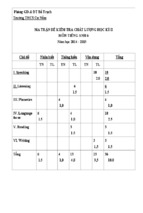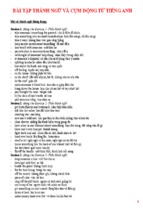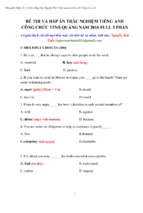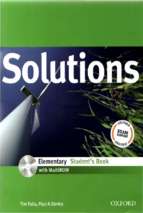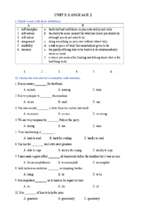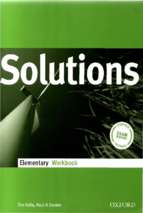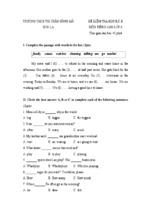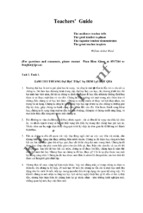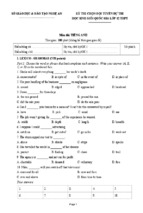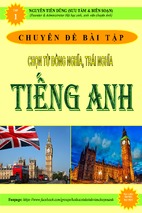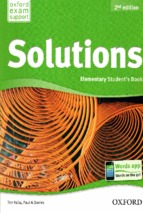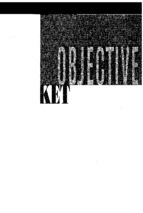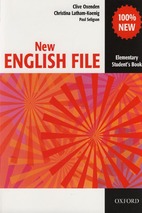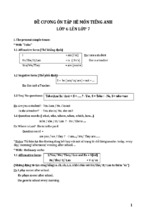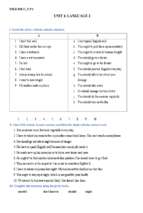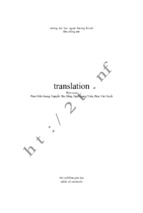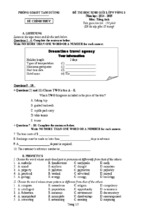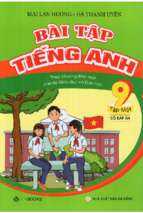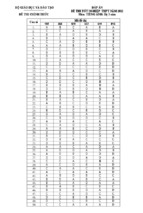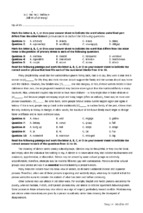A-PDF MERGER DEMO
SelectReadings
OXTORD
I]NIVERSITY
PRESS
OXFORD
I-INIVERSITY
PRESS
198 Madison Avenue, New York, NY 10016 USA
Great Clarendon Street, Oxford OX2 6DP England
Oxford NewYork
Auckland Bangkok BuenosAires CapeTown
Chennai Dar es Salaam Delhi Hong Kong
Istanbul Karachi Kolkata Kualalumpur
Madrid Melbourne Mexico City Mumbai
Nairobi Slo Paulo Shanghai Taipei
Tokyo Toronto
OXFORD is a trademark of Oxford Universitv Press.
rsBN0-19-438601-5
Copyright@2004OxfordUniversityPress
Library
Data
of Congress Cataloging-in-Publication
Bernard, Jean1944Select readings: upper-intermediate / by Jean
Bernard and Linda Lee
p.cm.
ISBN 0-19-438601-5
1. English language-Textbooks
for foreign
speakers
2. Readers. I. Lee, Linda. II. Title
PE1128.85344 2003
2003-056534
428.6'4-dc22
No unauthorized
photocopying.
AII rights reserved. No part of this publication may
be reproduced, stored in a retrieval system, or
transmitted, in any fom or by any means, electronic,
mechanical, photocopying, recording, or otherwise,
without the prior written permission of Oxford
University Press.
This book is sold subject to the condition that it shall
not, by way of trade or otherwise, be lent, resold,
hired out, or other"wise circulated without the
publisher's prior consent in any form ofbinding or
cover other than that in which it is published and
without a similax condition including this condition
being imposed on the subsequent purchaser.
Editorial Manager: Nancy Leonhardt
Senior Editor: Chris Balderston
Editor: Patricia O'Neill
Associate Editor: Nishka Chandrasoma
Art Director: Lynn Luchetti
Art Editor: Justine Eun
Production Manager: Shanta Persaud
Production Controller: Eve Wong
Cover design: Tom Hawley, Hawley Design
Cover photo: Andre Jenny/Alamy
Printing (last digit): 10 9 8 7 6 5 4 3 2 I
Printed in Hong Kong
ACKNOWLEDGMENTS
Realia by.'Aaron Hershman (pp. 94, 97, and 108),
Elizabeth Onorato (pp. 13, 24, 35, 47, 61, 73, 85, 98,
ll2,124,136, and 149)
Maps: Map Resource-Vector Atlas Collection/
Modified by Aaron Hershman (pp 169-173)
The publishers would, like to thank the
to reprod.uce
following for their permission
photographs:
O 2003 Estate of Pablo Picasso/
Artists Rights Society (ARS)/New York R6union des
Mus6es Nationaux/Art Resource) NY 2; From "A
Whack on the Side of the Head" by Roger von Oech/
Warner Books: 3; Alamy: John Foxx, 14; Clive Offley/
www.newint.org: 15; CMs Bttck: 25,26;
Popperphoto/Retrofile.com:
36; Reuters: Jim Bourg,
48; CafioonBank: Leo
37; ElektraVision/Indexstock:
Cullum, 49; Kjeld Duits: 62; Fred Weir: 74; Pictures
Colour Library/Alamy: 75; Krvame Zlkomo /
SuperStock: 86; Justine Eun/OL?: 87; Photo
Illustration by Rebecca Swi-ller, Photo by Robefi
Harbison/Christian Science ]Ionitor: 99; The
Pierpont Morgan Library/Art Resource, NY 100;
Indexstock: David Ball, I 13: Photodisc/Picturequest:
Scott T. Barter, 114; Brand X Pictures/Alamy: 125;
Archivo Iconographic, S.-{/ CORBIS: 126; CORBIS:
Roger Ressmeyer, 137; First Light,{tmageState: 138
The publishers would like to thank the
to reproduce
following Jor their permission
teJct:
p.4 From,A Whack on the Sitle o.fthe HeadbyRoger
von Oech. Copyright @ f9$3. 1990 by Roger von Oech.
By permission of Warner Books. Inc
15 FromNear Intentatioitqlisl. llay 1992 Used by
perTmsslon
26 From Li,fe, O 199E mIE Inc Reprinted by
perTmssron.
37 From Tlte Inteniational Hera\d Tribune, J:uly 3,
2002. Reprinted b1-permission
49 Reprinted with the permission of Humctn
Resources Maga.:irie (\ovember 2001). Published by
the Society for Hunan Resource Management,
Alexandria, \'{
63 This arficle first appeared inThink Magazine,
June l96l I-sed b1'pemtssion.
75 This arricle first appeared in The Chrtsti,an
Science lfotiitor: Copy'right @ Fred Weir. Used by
permission of the author.
87 Coplright e 2002, Th.eChroni,cle of Higher
Ed uaolirtn Reprinted with permission.
101 This arricle first appeared in The Christi,an
Sciettce Jlonitor on July 12,2002, and is reproduced
withperndssion. Copyright O 2002 The Christian
Science ]Ionitor (www.csmonitor.com). AJI rights
resen-ed.
l11 Coppight O 1999 U.S. Netus & World Report,
L.P. Reprinted with permission
126 From The Importance ofUnderstanding
Copfright O Ayer Company Publishers. Used by
pernussron.
138 From Slzaring the Uniuerse: Perspecti,aes on
Ertraten'estrial
LiJe, ptblished by Berkeley HiIIs
Books. Used by permission.
Acknowledgments
The publisher would like to thank the following teachers whose comments, reviews
and assistance were instrumental in the development of Select Readings:
Ann Mei-Yu Chang
Ann-Marie Hadzima
Beatrice Hsiao-Tsui Yang
Brett Reynolds
Chia-Yi Sun
Chi-Fan Lin
Ching-Kang Liu
Christine Chen-Ju Chen
Christopher E. Cuadro
Chuan-Ta Chao
Colin Gullberg
David WY. Dai
Douglas I-Ping Ho
Ellen Margaret Head
Florence Yi-Hui Chiou
Frances J. Shiobara
F\rjiko Sano
Greg Stinnett
Hideaki Narita
Hsiu-Chieh Chen
Hyun-Woo Lee
Jessica Hsin-Hwa Chen
Jong-Bok Kim
Jong-Yurl Yoon
Joyce Yu-Hua Lee
Kabyong Park
Kozuko Unosawa
Kun-liang Chuang
Kyungbin Yi
Maggie Sokolik
Makoto Shimizu
Maureen Chiu-Yu Tseng
Meredith Pike-Baky
Maosung Lin
Monica Li-Feng Kuo
Patricia Pei-Chun Che
Paul Cameron
Pei-Yin Lu
Peng-Hsiang Chen
Richard Solomons
Robin Cheng-Ilsing Tsai
Russell Lefko
Sherry Hsin-Ying Li
Stella Wen-Hui Li
Stephen Mendenhall
Stephen Slater
Steven Donald
Susan Shu-Hua Chou
Tsuh-Lai Huang
Won Park
Ying-Chien Chang
Yu-Chen Hsu
The authors would like to thank the following OUP staff for their support and
assistance in the development of Select Readings:
Chris Balderston
Julia Chang
Vickie Chang
Tina Chen
JJ Lee
Jason Lee
Chang Oh Lim
Hannahlee
Constance Mo
Paul Riley
Sumio Takiguchi
Cherry Wu
TedYoshioka
. iii
Scope and
quence
au,t
fntroduction
Chapter
ut.
I
What ls CreativeThinking?
2
"Bg changi,ng perspecti,ueand playi,ng u.ti,thour
knowledge, we cunmake the ordinary
ertraordinary and the unusual commonTtlnce."
Chapter 2 Why I Ouit the Company
l4
"I'd been used to Li,uingi,ndependently as a
student, looking aJter myself and organizing
nxA ou)n schedule. As soon as I star-ted uorking
all thnt chnnged."
Chapter 3 The BodyShop
25
"'I belieueI can build a hutnan lir^er,'ptoclaims
an erhau.stedDn Vacanti, collapsing into hi.s
offi.ce ch,o;ir."
Chapter 4 And the Big WinnersWere..-
36
"If one person found the joU in thk nou:
gargantuan business en@)ri,se, then soccer,
the game, is still a rsmarkable liJeJorce."
Chapter 5 ListenUp
48
"Many peoTtletend tn assunxeli,steni,ng i,s
basi,cally the some as hea,ring-a d,angerous
m'i,sconceptiortthnt leads to beli,euing that
efJecti,a
e Li,steni,ngis insti,nctiu e."
Warp YourJudgment
Chapter 6 Don't Let Stereotypes
"Stereotypesare cLki,nd of gossi,pabout the world,,
a gossiTtthat makes us pre-judge people before we
euer lag eAeson them."
l v .
62
Chapter 7 EastMeetsWeston LoveSRiskyCyberhighway 7+
"Like any Tthysical place, the Internet has
pred,ators hrki,ng about, and sometimes
they may be hard to sptot."
Chapter I
StudentsWon't Give Up Their FrenchFries
86
"Tlley ma,y be more health conscious, but
that doesn't necessarily Tneun thnt they're
eati,ng healthy."
Chapter 9 GettingInto the Game
99
"Tluis, I'm di,scouering, is a usodd in uhich
choice is the rule, boundaries shift at will,
and erperimentation i,s the nortrl."
chapter I o Callof rhe Riled
I 13
"Cell phones keep users in touch tnhether they are
on the road' at the grocery store, or i,n the midd,le
of a national park. And therein lies the problem."
Chapter | | The Art of Reading
125
"Read'ing or the enjogment of books has alu:ays
been regarded among the charms of a cultured liJe
and, is respected and enuied by those who rarely
gi,ue themselues that prLai,lege."
Chapter 12 When E.T.Calls
137
"With only a soft beeptas herald, the computers
hauefound that one channel in thi,s multi,tude
bears the hallmarks of ertraterrestrial origin."
s
169
. v
Scopeand Sequence
Reading
Content
iu
Building
Vocabulary
Chapter I
Suggestions
Identifying
Figures of
What ls
for learning to
main ideas
speech
Creative
think
Thinking?
creatively
Chapter 2
Explanationof
Distinguishing
Phrasal
Why I Ouit the
an employee's
fact from
verbs
Company
decision to
opinion
Langu
cus
e
Noun clauses
Past
conditional
sentences
resrgn
Chapter 3
The Body Shop
Using tissue
Inferencing
engineering
Using context
to guess
to repair the
meamng
Modals of
possibility
humanbody
Chapter 4
Impact of
Supporting
Using prefixes
And the Big
World Cup
main ideas
to determine
Winners
soccer on
players, fans,
Were...
Direct
quotations
mearLing
and host
countries
Chapter 5
Becoming an
Recognizing
Listen Up
effective
sentence
and
Using
punctuation:
listener
transitions
intensifiers
dashes,
Using adverbs
colons, and
semicolons
Chapter 6
Don't Let
Stereotypes
Warp Your
Judgment
vi .
Harmful
effectsof
stereotyping
Recognizing
Usingverbs as
Using relative
SOrlICCS
a{ectives
clauses with
uho, uhich, or
that
AAAAAA
AA
A
A
Scopeand Sequence
ntent
Reading
Skill
Building
Vocabularg
Langu
Focus
e
Chapter 7
Finding a
Recogtrizing
Using
East Meets
partner via the
diversepoints
moffiers
It's (rnt) +
verb + -ing
West on
Internet
ofview
Chapter 8
Students Won't
American
Scanning for
Idiomatic
Reported
students'
specific
expressions
speech
Give Up Their
obsessionwith
irformation
French Fries
food
Chapter 9
Getting Into
Appreciating
Following a
Compound
Gerunds as
the social and
storyline
words
complements
the Game
educational
Recognizing
paragraph
Slmonyns and
Reduced
antonyrns;
relatir-e
transitions
using suffixes
-Juland-l,ess
clauses
Word forms
Expressing
Love3 Risky
Cyberhighway
value ofelectronic garnes
Chapter l0
call of the Riled
Cellphone
etiquette
Chapter I I
Suggestions
Recognizing
The Art of
for becoming a
analogies
Reading
skillful reader
Chapter l2
Exploring the
possibility of
When E.T.Calls
extraterrestrial
similarity and
difference
Recognizing
scenanos
Nounsderil'ed
from
adjectives
Future perfect
life
. vii
> Introduction
Select Readings is a series of reading texts for pre-intermediate
through upper-intermediate students of English. In all the levels, highinterest reading passages serve as springboards for reading skills
development, vocabulary building, language analysis, and thoughtprovoking discussions and writing.
ln Select Readings-Upper-Intermediate,
the readings represent a
wide range of genres (newspaper and magazine articles, essays, and
book excerpts) gathered from well-respected sources such as the
Intetnational Herald TYi,bune, U.S. Neuts & World Report, and,Li,fe
magazine.
onen
The compl ete Select Read,ing s-Upper-fntermediate
includes the following components:
o Student Book
program
e Quizzes andAttsuser Kq.TYt:sis available for downloading at
wuu. oup.com,/elt/tea,cher/selectreod,ings.
This easy-to-use
instructor's companion includes an answer key for all activities in
the Student Book and a reproducible, one-pagequiz for each chapter.
o Cassettes/CDs.Tlvo accompanymgaudio cassettesor CDs feature
recordings of all of the reading passagesin the book.
The following principles have guided our approach throughout the
development of Select Reading s :
. Exposing students to a variety of text types and genres helps
them develop more effective reading skills. Students learn to
handle the richness and depth of writing styles they will encounter
as they read more widely in English.
viii .
Readers become engaged with a selection when they are asked
to respond personally to its theme. While comprehension
questions help students see if they have understood the information
in a reading, discussion questions ask students to consider the issues
raised by the passage.
Readers sharpen their reading, vocabular5r-building,
and
language analysis skills when skills work is tied directly to the
eontent and language of each reading passage. Ttris book
introduces students to reading skills such as skimming and scanning,
vocabulary-building strategies such as finding synonyrns and using
phrasal verbs, and language study topics such as reduced clauses.
Good readers make good writers. Reading helps students develop
writing skills, while writing experience helps students become better
readers.
Background knowledge plays an important role in reading
comprehension. An important goal of Select Readings isto
illustrate how thinking in advance about the topic of a reading
prepares readers to better comprehend and interact with a text.
ter Oaeraiew
Each chapter in Select Readings includes the eight sections described
below. Suggested time frames for covering the material are also given.
1. Opening Page (5 to l5 minutes)
The purpose of this page is to draw readers into the theme and content
ofthe chapter.
aching Suggestions:
. Call students'attention to the Chapter Focus box. Give them a
chance to think about the content and skills they are about to study
and to set their own learning goals for the chapter.
. Ask students to identify what they see in the photo or artwork on the
page and guess what the chapter is about. Have them read the
quotation, restate it in their own words, and then say if they agree
with it. Finally, ask what connection there might be between the
image and the quotation.
2. Before You Read (30 to 40 minutes)
One question in each Bejore You Read section asks students to reflect
on their prior knowledge of the chapter's topic. Giving students time to
think about and discuss this question is an essential part of helping
r i ;
them activate their background knowledge on the topic. A second
activity in the Before You Read, section invites students to practice prereading skills such as skimming and scanning. Effective readers use
these pre-reading skills regularly to get an initial feel for the content and
organization of the reading passage.
aclning Suggestions!
' Makesurethat studentsunderstandthe purposeof the BeforeYou
Read actiities. Explain that activating prior knowledge will help
them to better comprehend the reading passage.
e EncouraSe student participation in the activities by having people
work in small groups to complete the activities.
o React to the content of students' ideas rather than to the grammatical
accur acy of their resp onses.
3. Reading Passage (60 to 75 minutes)
In general, the readings become increasingly longer and more complex
as the chapters progress. To help students successfully tackle each
passage we have provided the following support tools:
Vocabularg glosses. Challenging words and expressions are
glossed throughout the readings. In most cases, we have glossed
chunks of words (e.g.,launch a campaign) instead of individual
vocabulary items (e.g.,launch). This approach helps students develop
a better sense of how important context is to understanding the
meaning of new words.
Culture and Languoge Notes, On pages 150-168, students will
find explanations for cultural references and language usage that
appear in blue type in the readings. Notes are provided on a wide range
of topics from scientific information such as NASA, to geographical
references such as the former U.S.S.R.,to famous people such as
Lewis Carroll.
Numbered lines. For easy reference, every fifth line of each
reading passage is numbered.
Recorded reading pdssa,ges. Listening to someone reading a text
aloud helps language learners see how words are grouped in
meaningful chunks, thus aiding comprehension.
At the end of each reading, there is a short section giving biographical
information on the author or information about the source. This
information helps students develop a richer context for the perspective
of each author.
x .
aching Suggestions:
. Encouragestudents to read actively. Circling words, writing
questionsin the margins, and taking notes are three ways in which
students can make reading a more active and meaningful experience.
. Make sure students know how to use the vocabulary glosses,
Culture and Language Notes, and other support tools to assist them
in the readingprocess.
o Encouragestudents to use context to guessthe meaning of
unfamiliar words.
. Play the recordedversion of the readingpassageand ask studentsto
Iisten to how the reader groupswords together.As they listen to the
recording, studentscan lightly underline or circle the groups of words.
4. AtrberYou Read: Understanding the Text (30 to 45 minutes)
Following each reading, there are two post-readingactivities that give
students the chanceto (a) clarify their understanding of the text, and
(b) discussthe issuesraised in the reading. The comprehension
questionsare for students to work through on their own. Questionsin
the Consi,derthe Issues section, on the other hand, ask students to talk
about ideas introduced in the reading.
aching Suggestions:
o Get students to discusstheir reactions to the readingsin pairs or
groups. The process of discussingquestions and answersgives
students an opportunity to check their comprehensionmore
critically and analyzetheir reactions to the passages.
r Show students the value of returning to the reading again and again
to answer the comprehensionand discussion questions.Ask them to
point out the specific places in the reading where they have found
answersto the questionsposed.
o If time permits and you would like students to have additional
writing practice, ask them to write an essayor a journal entry on one
of the questionsin the Consider the Issues section.
5. Reading Skills (20 to 30 minutes)
At the beginning of each Reading Skilk section, students encounter a
shorbexplanation of the skill in focus and, when appropriate, an
example of how that skill relates to the reading in the chapter.The task
following this explanation asks students to return to the reading to
think about and apply a new reading skill.
. x l
aching Suggestions:
. Discuss the general purpose of developing reading skills. The more
students understand the rationale behind acquiring these critical
skills, the more motivated they will be to develop and refine them.
. Review the explanations and sample sentences at the beginning of
each Read,i,ngSkiIIs section before asking students to tackle the
questions that follow. Encourage them to ask any questions they
have about the explanations or examples.
. Reflect with students on the ways in which they can apply the
reading skills they have learned in each chapter to other reading
passages and to other reading genres.
6. Building Vocabulary (2O to 30 minutes)
Reading extensively is an excellent way for students to increase their
vocabulary base. Considering this, we pay careful attention to
developing students'vocabulary-building skills in each chapter of
Select Reading*
Understanding phrasal verbs, working with word
forms, finding sJmonyrns, and a variety of other vocabulary-building
skills are taught throughout the book. Like the reading skill activities,
each Buildi,ng Vocabulary section starts out with a short explanation
and, when appropriate, examples of the skill in focus. In the activity
that follows the explanation, students typically scan the reading to
gather and analyze various types of words.
aclring Suggestionsi
. Review the explanations and sample sentences at the beginning of
each Building Vocabulary seclion before asking students to tackle
the questions that follow. Encourage them to ask any questions they
have about the explanations or examples.
r Show students the value of returning to the reading to find an answer
whenever they are unsure of a vocabulary-related question.
o Encourage students to keep a vocabulary notebook. Present various
ways in which students can organtze the words in their notebook: by
chapter, by topic, by part ofspeech, etc.
o Discuss the value of using an English-English learner's dictionary to
find the meanings of unfamiliar words.
7. Language Focus (2O to 30 minutes)
The final skill-building section in each chapter calls attention to important
grammatical structures and functions that occurwith some degree of
frequency in the reading passage.The goal of this section is to focus
students' attention on critical grammax points as they occur in context.
xii .
aching Suggestions:
. Review the explanations and sample sentences at the beginning of
each Language Focus section before asking students to tackle the
questions that follow Encourage students to ask any questions they
have about the exlplanations or examples.
o Invite students to talk about what they already know about the
Ianguage point in focus. Many students know a great deal about
grarnmar and are pleased to demonstrate this knowledge.
. Underscore the fact that lhe Language Focus sections are intended
to help students review language they have already learned in the
context of an authentic reading passage. It can be very valuable for
students to see the ways in which grammatical structures they have
studied appea"rnaturally in real-life reading selections.
8. Discussion and Writing
(45 to 60 minutes)
At the end of each chapter, students have an opportunity to talk and
write about avariety of issues. The questions in this section provide
students with a chance to broaden theirview on the topic of the reading
and to address more global issues and concerns.
aching Suggestions:
. When time permits, Iet students discuss a question a second time
with a different partner or group. This allows them to apply what
they learned in their first discussion of the question.
o Choose one or more of the questions in this section as an essay topic
for students.
Bonus Features
Crossuord Puzzles. At the end of each chapter, you will find a
crossword prtzzle that recycles and reviews some of the key vocabulary
from the reading. These ptnzles can be used as homework, as optional
activities for groups or individuals who finish other exercises early, or
as review activities several weeks afber completing a chapter.
MWsEach Iocation mentioned in a reading passage is clearly marked
on one ofthe maps found on pages 169-173.
This project grew out of our deep and profound love for reading, and for
sharing this love of reading with our students. In developing Select
Readings, we have enjoyed the process of talking to teachers all over
the world about they types of authentic selections they feel their
students enjoy the most, and learn the most from. We hope that you and
your students enjoy teaching and learning with Select Read.ings.
Jean Bernard
Linda Lee
. xiii
What ls Creative
Thinki
ng?
Chapter
Picasso's Head of Bull
Creatiae minds hare
alwags been known to
suraiae any kind of
bad training.
-Anna
Freud
COII{TEI,{T:
Suggestionsfor learning to think
creatively
READING SKILL:
Identifying main ideas
Psychoanalgst
(18s5-1982)
Figures of speech
Noun clauses
2 Chapter 1 " What Is Creati,ueThinking?
l . Look at the title of the article on page 4. What axe some possible
answers to the question, "What is creative thinking?" Give an
example of someone who thinks creatively.
2 . In your opinion, is it important for people to learn to think
creatively? Does it help people be more successful? Why or
why not?
3 . The figure below can be seen in three different ways. Which ways
can you see? Can you see something different as weII? How is
this an example of creative thinking?
'asouslr uo
IIBq€ 3uq33nt
'u,t.op aprsdn tun} nozt;1'4reur uorlsanbe aq
€
a{rl
$Iool
lr
}I
I"as
pFoc 1r'fem "raqlouelI X€{ool no,{;1 'p.rrqe s,lr '.{e,uauo }r lB 4oo1nod g
r
J
Passage
WHAT IS CREATIVE THINI(ING?
by Rogervon Oech
fromA \thack on the Side o.fthe Head:
Hotp You Can Be More Creatiae
Note: Erplanations Jor zoords in blue type can befound i,n the
Culture and Language Notes on pages 150-168.
I once asked advertising legendl Carl Ally what makes the
creative person tick.2 Ally responded, "The creative person wants to
be a know-it-all. He wants to know about all kinds of things: ancient
history, nineteenth century mathematics, current manufacturing
techniques, flower arranging, and hog futures.3 Because he never
knows when these ideas might come together to form a new idea. It
may happen six minutes later or six years down the road. But he has
faith that it will happen."
I agree wholeheartedly. Knowledge is the stuff from which new
1 0 ideas are made. Nonetheless, knowledge alone won't make a person
creative. I think that we've all known people who knew lots of facts
and nothing creative happened. Their knowledge just sat in their
craniaa because they didn't think about what they knew in any new
ways. The real key to being creative lies in what you do with your
1 5 knowledge.
20
Creative thinking requires an attitude that allows you to search for
ideas and manipulate your lrnowledge and experience.s With this
outlook,6 you try various approaches, first one, then another, often
not getting an5,'where.You use crazy) foolish, and impractical ideas as
stepping stones to practical new ideas. You break the rules
occasionally, and explore for ideas in unusual outside places. In
I advertising legend
advertising
2 make a person tick
a person who has become falrlous in the field of
what makes a person behave the way he or she does
3 futures
shares in the stock market that are bought or sold in advance
of delivery
I crania
skulls (plural form of cranium)
:' manipulate your knowledge and experience
and erperience in different ways
" outlook
4 Cltaptei' 1 '
point of view
Illtat Is Creutit'e Thirtking?
use your knowledge
short, by adopting a creative outlook you open yourself up both to
new possibilities and to change.
25
30
35
40
45
50
55
A good example of a person who did this is Johann Gutenberg.
What Gutenberg did was combine two previously unconnected ideas:
the wine press and the coin punch. The purpose of the coin punch
was to leave an image on a small area such as a gold coin. The
function of the wine press was, and still is, to apply force over a large
areato squeeze thejuice out ofgrapes. One day Gutenberg, perhaps
after he'd drunk a goblet or two of wine, playfully asked himself,
"What if I took a bunch of these coin punches and put them under the
force of the wine press so that they left their image on paper?" The
resulting combination was the printing press and movable Qrye.
NalXr AdmiralT Grace Hopper had the task of explaining the
meaning of a nanosecond to some non-technical computer users. (A
nanosecond is a billionth of a second, and it's the basic time interval
of a supercomputer's internal clock.) She wondered, "How can I get
them to understand the brevity of a nanosecond? Why not look at it
as a space problem rather than a time problem? I'lI just use t]re
distance light travels in one billionth of a second." She pulled out a
piece of string 30 centimeters long (11.8 inches) and told her visitors,
"Here is one nanosecond."
In 1792, the musicians of Franz Joseph Haydn's orchestra got
mad because the Duke promised them a vacation, but continually
postponed it. They asked Haydn to talk to the Duke about getting
some time off. Haydn thought for a bit, decided to let music do the
talking, and then wrote the "Farewell Symphony." The performance
began with a full orchestra, but as the piece went along, it was
scored8 to need fewer and fewer instruments. As each musician
finished his part, he blew out his candle and left the stage. firey did
this, one by one, until the stage was empty. The Duke got the message
and gave them a vacation.
Then there's P lo Picasso. One day, he went outside his house
and found an old bicycle. He looked at it for a little bit and took off
the seat and the handle bars. Then he welded them together to create
the head of a bull.
Each of these examples illustrates the creative mind's power to
transform one thing into another. By changingperspective andplaflng
with our knowledge, we can make the ordinary extraordinary and the
Navy Admiral
an officer of very high rank in the navy who commands
a group of ships
scored written in musical notation format with specific parts for each
instrument
o
$
60 unusual commonplace. In this way, wine presses squeeze out
information, string is transformed into nanoseconds, labor grievances
become sSrmphonies,artd bicycle seats turn into bulls' heads.
65
The Nobel Prize winning physician Albert Szent-Gyiirgyi put it
welle when he said: Discovery consists of looking at the same thing as
everyone else and thinking something different.
Here are two quick exercises to give you a chance to "think
something different."
70
Exercise 1: An eccentriclO old king wants to give his throne to one
of his two sons. He decides that a horse race will be run and the son
who owns the slower horse will become king. The sons, each fearing
that the other will cheat by having his horse run less fast than it is
capable, ask the court fool for his advice. With only two words the
fool tells them how to make sure that the race will be fair. What are
the two words?
75
Exercise 2t Can you think of a way in which you put a sheet of
newspaper on the floor so that when two people stand face to face on
it, they won't be able to touch one another? Cutting or tearing the
paper is not allowed. Neither is tying up the people or preventing
them from moving.
80
Why don't we "think something different" more often? There are
several main reasons. The first is that we don't need to be creative for
most of what we do. For example, we don't need to be creative when
we're driving on the freeway,lr or riding in an elevator, or waiting in
Iine at a grocery store. We are creatures of habit when it comes to the
from doing paperwork to tying our
business of living-everything
shoes to hagglingl2 with telephone solicitors.
85
90
For most of our activities, these routines are indispensable.
Without them, our lives would be in chaos, and we wouldn't get much
accomplished. If you got up this morning and started contemplating
the bristles on your toothbrush or questioning the meaning of toast,
you probably wouldn't make it to work. Staying on routine thought
paths enables us to do the many things we need to do without having
to think about them.
I
put it well
expressed the idea well; made the point
having some strange or unusual ideas or ways of doing
l0
eccentric
things
1I
freeway
a Iarge highway with no tolls
t2
haggling
arguing, usually over money
6 Chapter 1 . What Is Creatiue Thi'nking?
95
Another reason we're not more creative is that we haven't been
taught to be. Much of our educational system is an elaborate game of
"guess what the teacher is thinking." Many of us have been taught to
think that the best ideas are in someone else's head. How many of
your teachers asked you, "What original ideas do you have?"
There are times, however, when you need to be creative and
100 generate new ways to accomplish your objectives. When this
happens, your own belief systems may prevent you from doing so.
Here we come to a third reason why we don't "think something
different" more often. Most of us har,-ecertain attitudes that lock our
thinking into the status quo13 and keep us thinking "more of the
105 same." These attitudes are necessary for most of what we do, but
they can get in the way when we're trying to be creative.
From A Whack on the Si,deof the Hearl: Hr..,tt'You Can be More
Creati,ueby Roger von Oech. This best-selling book has been praised
by business leaders, educators. ar-tlsts.and anyone hoping to unlock
the power of the mind to think creanr e11.It has been translated into
11 languages and used in sernilars alorurd the rvorld.
er You Read
Unders
the
xt
A, Multiple choice. For each item below, circlethe bestanswer.
| . The main purpose of the readingis to -.
a. explain how the printing press was invented
b. teach readers how to think creatively
c. explain why Haydn wrote the "Farewell Symphony"
d. criticize teachers and educational svstems
13 status quo
(from Latin) the way things are
t
f
- Xem thêm -

